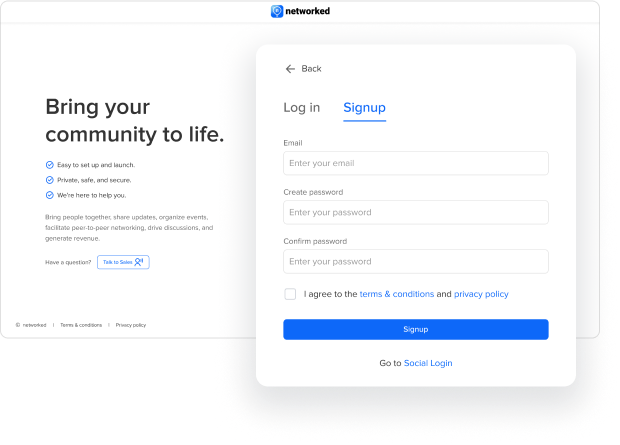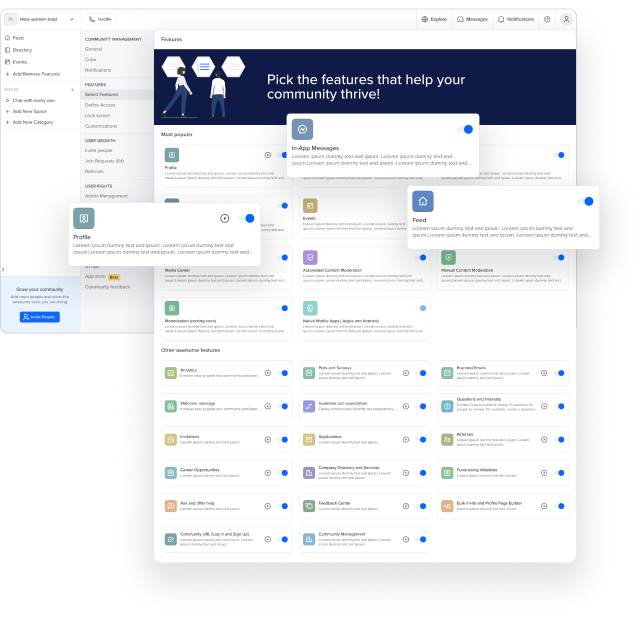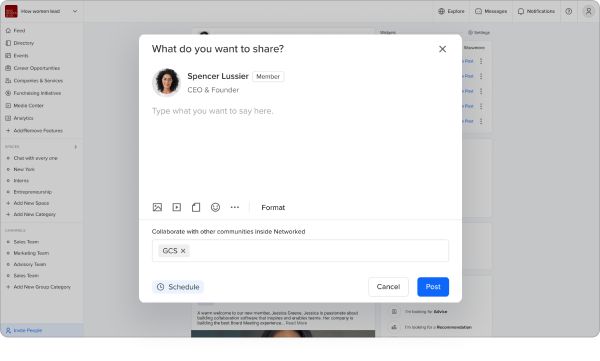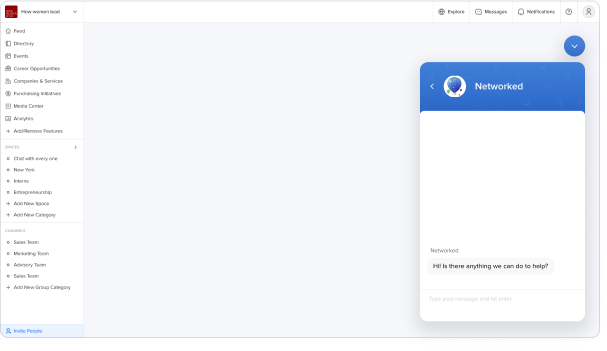A Guide to Creating a Successful Community
Unlock the potential of Networked’s powerful platform by following our expertly crafted guides and tutorials. Step-by-step, learn how to curate an exceptional community, complete with captivating content, interactive discussions, and personalized profiles. Elevate your online presence, foster meaningful connections, and create a vibrant and great-looking community that leaves a lasting impact.
Follow these steps below –
Step
1
.
Define Your Community Vision and Goals:
Conduct thorough research to identify the purpose and objectives of your community. Clearly articulate the problem you aim to solve or the value you want to provide to your members.
Create a mission statement that captures the essence of your community’s vision.
Define specific goals and metrics to measure the success of your community, such as member engagement, growth, or revenue generation.

Step
2
.
Choose the Right Networked Plan:

Networked offers different plans, such as Community, Business, and Pro. Each plan provides varying features and capabilities.
Assess your community’s requirements and budget to determine which plan aligns best with your needs.
Consider factors like the number of members, desired customization options, monetization features, and customer support.
Step
3
.
Set Up Your Networked Community:
Sign up for a Networked account by visiting the official website (networked.co) and following the registration process.


During the setup, choose a custom domain name that reflects your community’s brand, or utilize the subdomain provided by Networked.
Take advantage of the branding options available, such as adding your logo, selecting appropriate colors, and setting a captivating cover photo.

Step
4
.
Customize Your Community’s Look and Feel:

Access the customization options within Networked to tailor the appearance of your community to match your brand identity.
Modify the layout and structure of your community by selecting from the available templates or creating a custom design.
Choose fonts, colors, and visual elements that align with your community’s theme and appeal to your target audience.
Craft a compelling welcome message and community description that clearly communicate the value and purpose of your community.
Step
5
.
Structure Your Community:
Design a logical and intuitive structure for your community that facilitates easy navigation and content discovery.


Create groups, subgroups, or categories based on the topics, themes, or interests that your community revolves around.
Consider the hierarchical organization of your groups to accommodate different levels of discussions or specialized areas.


Determine the access levels and permissions for different types of members, such as admins, moderators, contributors, or regular members.
Step
6
.
Create Engaging Content:
Develop a content strategy that caters to your community’s interests, needs, and preferences.


Plan a content calendar to ensure a consistent flow of valuable and relevant content.
Utilize a variety of content formats, such as articles, discussions, polls, videos, live events, or webinars, to cater to different member preferences.
Encourage members to contribute their own content, fostering a sense of ownership and engagement within the community.

Step
7
.
Invite and Onboard Members:

Implement a multi-channel marketing strategy to attract potential members to your community.
Leverage social media platforms, email marketing, content marketing, and partnerships to promote your community and reach your target audience.
Develop a compelling value proposition that clearly communicates the benefits of joining your community.


Create an onboarding process to guide new members and familiarize them with the features and functionalities of the Networked platform.
Provide clear instructions on how to navigate the community, access content, engage in discussions, and connect with other members.
Step
8
.
Foster Community Engagement:
Actively encourage member engagement and participation within your community.
Promote discussions, ask thought-provoking questions, and spark conversations around relevant topics.
Respond promptly to member queries, comments, and feedback to show that their voices are heard and valued.
Recognize and highlight valuable contributions from members, fostering a sense of community and belonging.
Organize community events, challenges, or contests to further engage and motivate members.

Step
9
.
Provide Ongoing Support and Moderation:

Establish clear community guidelines that outline expected behavior, rules, and etiquette.
Enforce the guidelines consistently to maintain a positive and safe environment for all members.
Appoint moderators or administrators who can actively monitor the community, moderate discussions, and address any violations or conflicts that may arise.
Foster a culture of respect and inclusivity within the community, and promptly address any member concerns or disputes.
Step
10
.
Promote and Grow Your Community:

Continuously market and promote your community to attract new members.
Collaborate with influencers, thought leaders, or relevant organizations in your niche to expand your reach.
Leverage search engine optimization (SEO) techniques to optimize your community for organic discovery.
Utilize referral programs or incentives to encourage existing members to invite their peers or colleagues to join.
Leverage email marketing, social media, and content marketing to consistently communicate the value and benefits of your community.
Step
11
.
Analyze and Optimize:

Regularly analyze community metrics and analytics provided by Networked to assess the performance and impact of your community.
Monitor member engagement, growth rates, content consumption, and interaction levels.
Gather member feedback through surveys, polls, or direct communication to understand their needs, preferences, and suggestions for improvement.
Use the insights gained to identify areas for optimization and make data-driven decisions to enhance member experience and community outcomes.
Step
12
.
Evaluate Monetization Options (if applicable):

Assess the feasibility and desirability of monetization strategies for your community.
Consider options such as membership fees, premium content, courses, coaching services, sponsored content, or partnerships.
Carefully balance monetization efforts with maintaining the value and integrity of your community.
Implement monetization strategies gradually and transparently, ensuring that they align with the interests and needs of your members.
Step
13
.
Iterate and Evolve:

Continuously evaluate and iterate on your community strategy based on member feedback, changing needs, and emerging trends.
Stay updated with new features, updates, and enhancements released by Networked, and explore how they can benefit your community.
Regularly solicit feedback from members and involve them in the decision-making process for community improvements.
Adapt and evolve your community’s features, content, and engagement strategies to ensure long-term sustainability and member satisfaction.

